Usborne Puzzle Adventures: Escape from Blood Castle
Pagescan Adventures: Let’s Read - the hit new innovation that has nothing to do with video games, but doesn’t require me to record video. Genesis Edition!
To recap, Usborne Puzzle Adventures are still puzzle adventure story quiz drama comedy books for young lads and lasses who like puzzles and like stories but were born before the Harry Potter children’s literature renaissance. Also for individuals with genius-level intelligence as sometimes these puzzles only make any sense to the person who wrote them, and oftentimes are kind of shoehorned in because, help, we’ve reached the end of another double-page spread but haven’t packed in the full puzzle quota yet! But this is part of their charm. The silliness of the puzzles goes along with the silliness of the plots, and here we have a fairly silly early entry in the series - the earliest, in fact. Escape from Blood Castle, the very first Usborne Puzzle Adventure of them all. As ever, by which I mean “as twice before,” I’ll be pairing each puzzle up with its designated Clue and then revealing the official Answer, and then I will criticise both.
Normally I’d show you what the book looks like, but this time it’s a bit different…

I mentioned before that I used to own the first three, in fact, UPAs in a compilation volume, and this is it, discovered in an ancient box when I moved house. We’ve already done one of the books in this volume - The Curse of the Lost Idol - and there’s one more included, so we’ll be reading more of these Solve Your Own Mystery Stories, so the protagonists don’t have to. This rather inept omnibus doesn’t give proper copyright details or authorial credit for the three individual books, but thanks to the wonders of the Internet I can tell you that this was published in 1985 - nearly thirty years, wow, it honestly doesn’t feel quite that old - and will set you back nearly two hundred pounds if you want to buy it online, so it’s a good thing I dug it out of my loft so I can skim some suckers on Amazon Marketplace (yeah, like anyone ever buys those extortionate second-hand editions). The author of Escape from Blood Castle was Jenny Tyler and the book was designed and illustrated by Graham Round. You have a lot to answer for, you two.
Let’s Read the back cover.
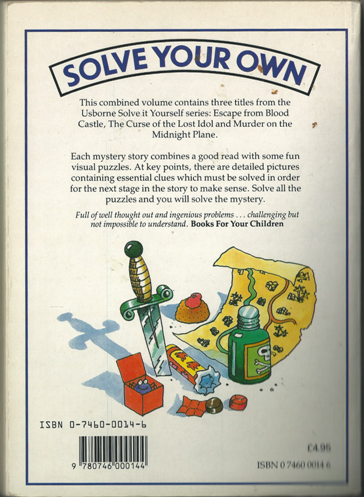
“challenging but not impossible to understand” - well, we’ll see about that… actually, by modern standards this is kind of an odd back cover, in that it offers not so much a synopsis as a description of how the books are constructed. Perhaps, judging by the review from Books For Your Children, it’s actually aimed at parents, as it’d be a bit weird to have that as your go-to puzzle book source as a child, and I’m not sure if kids in the eighties could scrape together the shekels for such an exorbitant payout as £4.95. (ThisIsMoney.co.uk tells me that that would be £10.92 in today’s terms! That’s $17.76, American readers, credit of XE.com. I am all about the attributions today.) Anyway, I suppose we get a good enough idea of what to expect from the plots by the titles given, not to mention the illustrations. Candy, maps, and spiders. Everything you need to write an Usborne Puzzle Adventure. Behold the bafflement of Escape from Blood Castle…
Oh, and I’ll let the omnibus introduction take us through the rigmarole of how this thing reads. Again. Like we needed to hear it twice. Sometimes these books assume you’re quite dim, but other times they seem to expect you to be a genius.
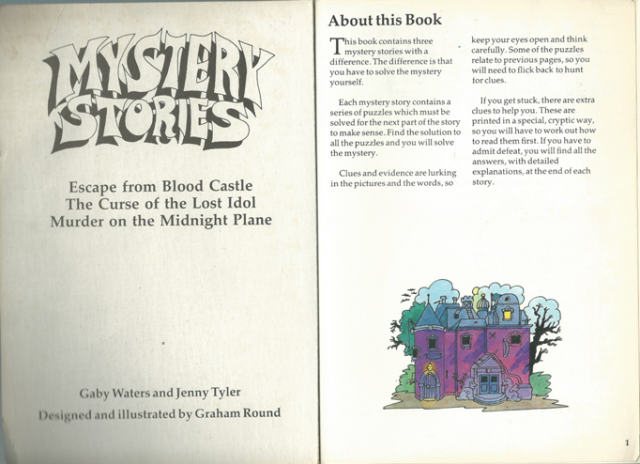
I kind of think these intros are written in-universe, too - in a world where writing hints in mirror writing is genuinely special and cryptic and not something that can be identified at a glance. Figure out how to write backwards, and you’ll confound the police, if not an eleven-year-old trespasser. Well, it was for kids. Well, no, it was for kids to make them feel smart. Apparently it didn’t work, as later on they stopped writing the hints backwards and just presented them normally… I don’t know if the puzzles were hard for the readers these books were aimed at, but I dare say I couldn’t have done them, since I didn’t exist at the time, so fair enough. Oh, that’s Blood Castle down there, by the way. Spoilers!
But now for something a little more specific. Say hello to our brave and totally believable hero:
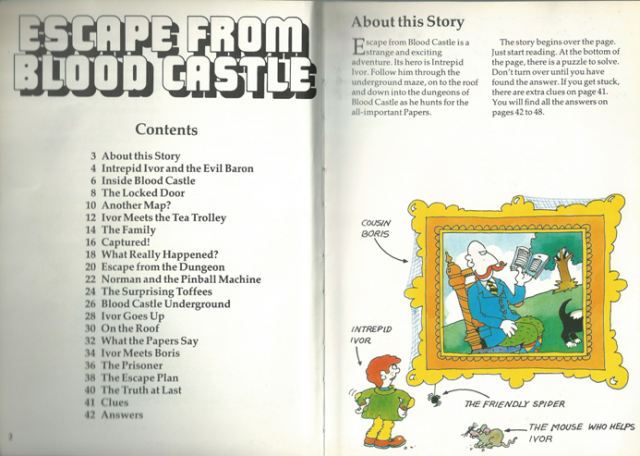
Ivor is Intrepid, and he wants Papers. There are no useful stationers’ nearby. The newsagent has shut down. Infiltrating his relatives’ castle is all he has. That’s the backstory of this book, more or less, and you really shouldn’t question it because it makes less sense as the storystory goes on. This book is considerably goofier than subsequent entries, which at least tried to pretend that its gormless protagonists were crudely-drawn everypersons existing in a world like yours or mine back in 1985, assuming you had been born or were capable of reading by then. Readers who were children in 1985: Did you have patches sewn onto the elbows of your jacket, and make friends with spiders and mice? I know it was a poorer time, so I guess I’ll believe anything. Still, though. Sweet moustache there, Boris. You should probably see a doctor about those ears, though.
Okay, this is meant to be a puzzle adventure, let’s get on with some puzzles. Some official puzzles, rather than just the mysteries of 1980s culture.
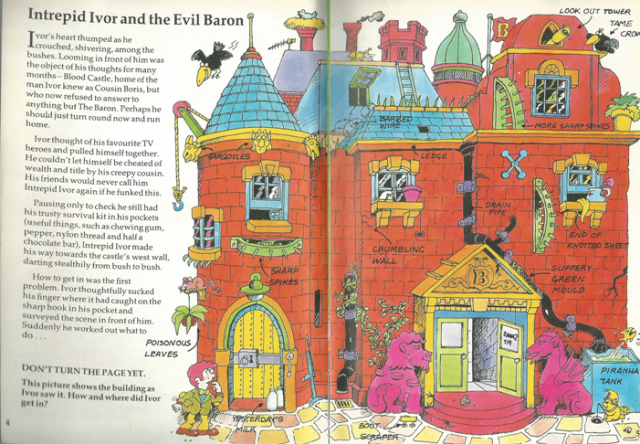
Escape from Blood Castle begins with us trying to enter Blood Castle. Ivor, did you even read the title?
But this is new - or rather, old. Whereas the previous two UPAs I pagescanned - one of which came literally right after this - had plotty intro double-pages that set up the story, this one throws us into a puzzle straight away. Good on you, Escape from Blood Castle.
Whoa, though, that illustration! Look at all those labels - what is this, a bad political cartoon? I think we know sharp spikes, drain pipes, and barbed wire when we see them. Maybe not tame crows, though, which apparently have different-coloured beaks to wild crows. Must be a shiny version. But no, we mustn’t get distracted - we have to help Intrepid Ivor continue to be Intrepid or his friends will never let him live it down. Apparently being Intrepid means sneaking into a relative’s run-down manor house while wearing his favourite Eleventh Doctor cosplay that he learnt of from the man himself using time-travel. Oh, but he’s being cheated out of his wealth and title by said cousin! That changes things - big things, like the laws on breaking and entering. Ivor’s friends don’t sound very sympathetic to his plight, though, if instead of joining him on his quest they’re planning to mock him if he funks it. Must be at private school. Where there’s every reason to be afraid when the older boys start talking about funking things.
It’s a pretty good puzzle by certain standards, though. You have to read the text and the illustration in detail to know everything you’ve got to work with. And the Ekans Tip gives us the perfect tool we need to prepare for the obligatory clues, which to be fair you might need, as you can never be sure how creatively you’re meant to be interpreting these illustrations…
Let’s once again debut the Clues page…

I think that it would’ve been funnier if they’d printed SNAKE PIT the right way around in the mirrored clue, since it was already mirrored. But anyway, this tells us what we need to know, and that is that the key to one’s problems is always, always a literal one. In puzzle books, anyway. They aren’t very good at being cryptic, despite, you know, puzzles.
I won’t spoil the answer to this one, but I’m pretty sure I have it right - or have remembered it. It involves nylon thread, a bloodstained hook, and poison ivy.
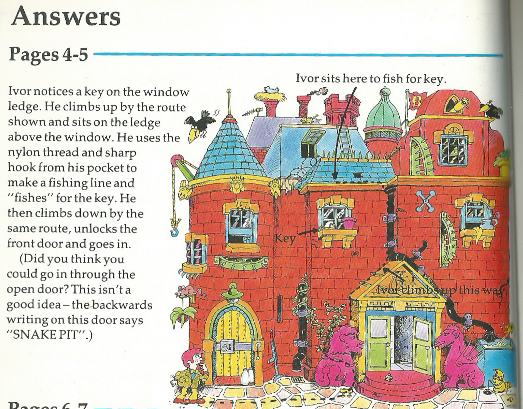
Uh, my apologies for the image quality; it looked better on my computer. So, that solution… wow, that was more complicated than I thought. I figured he’d climb up the ivy, brace himself at the top of the lower drain pipe, and try and fling his grappling hook upwards to snatch for the key. Really, climbing up to the roof and sitting on a narrow ledge on a building with crumbling masonry is meant to be the safer option?
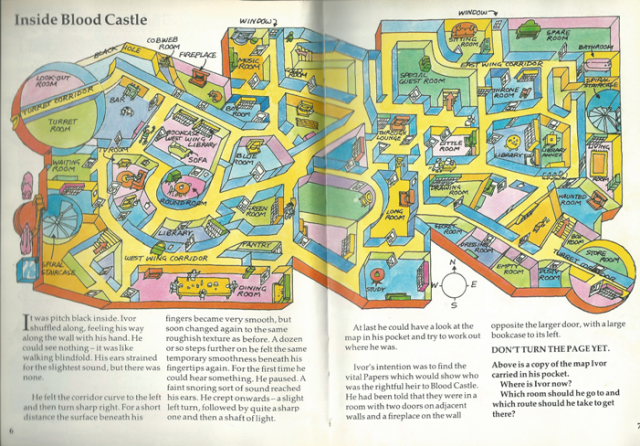
Years later, this map is my abiding memory of this book. I remember learning the word “adjacent” from this puzzle. I mean… just look at that thing. Wow. It’s overwhelming. What’s nice is that the far-left side is totally consistent with the previous pages! What’s not nice is that there’s no actual way to enter many of the rooms, including the Look-Out Room, Turret Room, and Black Hole. Well, I can see why you might want to avoid a Black Hole…
What we have here is actually a double puzzle, where later Usborne Puzzle Adventures might be content to have just one. You have to use the textual clues to figure out first where Ivor is, which is kind of hard, and then use the text to figure out where he wants to be, which is kind of easy once you learn the word “adjacent.” It’s a really strong use of text-picture interaction, and you rarely see it quite this deep, in my recollection. I’m very fond of this map. There’s just so much detail in there, and I really admire the effort.
Once you understand the terms the book is working under - walls are rough and doors are smooth, apparently - and especially so long as you remember where you’re meant to be starting from, picking up on Ivor’s present location becomes simple. As for where he wants to be, though - that’s tougher to narrow down because there are so many places to look through, and I think it may have been difficult enough for me whenever I first read this book that the solution is now seared into my brain (or at least, I can’t help thinking about it whenever I use the word “adjacent” - wow, I’m broken). But it’s actually more or less where you’d expect. Still, do we at least get a hint?

Smooth areas being doors is probably the least intuitive part of the puzzle… but even if you didn’t understand that, it’s not really necessary to do so to solve the riddle. No clues on where Ivor should be going, though? As to how he gets there… well, as on any maze, it’s always the most winding, unintuitive route possible, so you don’t run into random zombies, cavemen, and tea ladies.
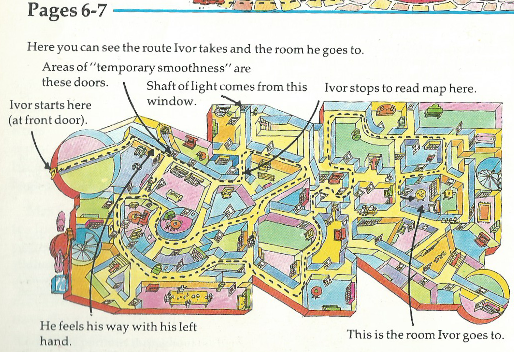
Voila. It’s a good thing Ivor’s map tells him the fixed and immutable positions of the bizarre monster wardens.
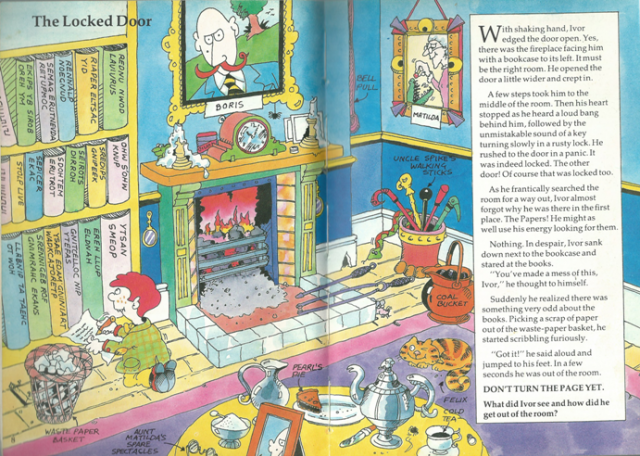
To the library! Not that this page actually tells you that it’s the library. As it said in the intro, you need to solve the puzzles to understand what’s going on - to a certain extent. It’s more that it doesn’t resolve the cliffhangers.
Lot of fire in here for a library, though. And… abandoned afternoon teas. I get the feeling Cousin Boris doesn’t pay the servants enough. Maybe they locked Ivor in under the belief that they were offing an obnoxious relative - a sort of Gormenghast thing, you know. Bad luck on the old Papers business, Ivor. Should probably have put your faith in a better source than an anonymous non-character we never meet or hear of again.
There’s a fine line between a cartoonist’s captions and the title on a book’s spine, and this page crosses it, I fear. Golly, though, I just can’t figure out what the riddle is to those books, despite mirror writing being a staple of this puzzle book so far. Let’s look for a hint, they’re easy to read.

“Code” is laying it on a bit strong there, especially to read the hints you have to decode them in exactly the same way! The real code is whether you’re also meant to read the second line first. “Spiders Keeping” doesn’t make a great deal of sense as a title, but then again, neither does “Poems Nasty”…

Oh, so the bookcase is also full of spoilers? Burn them immediately. …Somehow. The books on the lowest shelf appear to be larger than Ivor himself. Good luck pulling the handle, mate. You’ll need it.
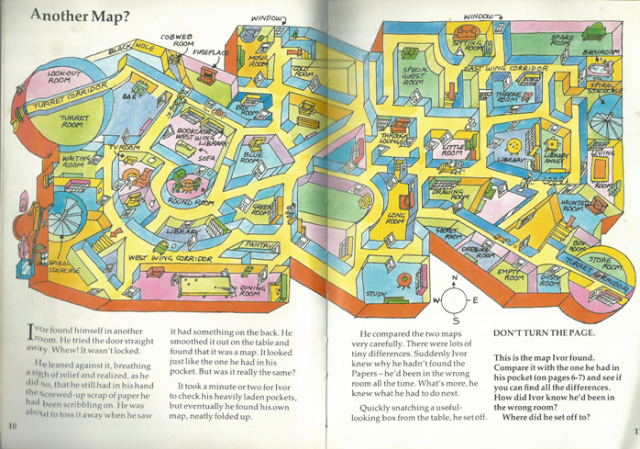
Do not adjust your Internet. I have not accidentally pasted the last-but-one double-page again. It’s different. …Slightly.
To Graham Round’s credit, close study suggests to me that he literally redrew the whole thing - it’s not a copy-paste. I mean, yeah, sure, the effect is of a virtual copy-paste, and obviously referencing and tracing were involved, but it all appears to have been redone from scratch, judging from some of the finer details on things that aren’t meant to be different - the linework on individual doors…
It must be said, spotting the differences can be quite fun. Some of the changes make the map look more like it’s simply the same place, only later - the zombie near the entrance has moved on, for instance… in fact, wherever there’s a living thing, it’s moved from the first map or has only just appeared. I’m not quite sure why an official map of the household shows someone approaching a door, for instance - I almost wonder if the brief for this page changed at some point. But really, it’s just flavour. And it still looks great.
As to the essential puzzle itself… well, it’s a tricky one. Very finicky. I honestly don’t remember the answer. And I think it more or less depends upon your interpretation of the words “to its left.”

Well that’s, uh, very interesting, but it doesn’t really affect the puzzle itself…? Great hint there. Is it really a hint if it has nothing to do with the answer?
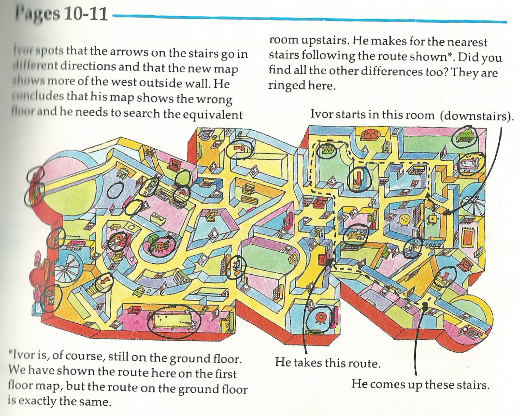
Wait, what. That’s the answer. The two floors of the house are identical save for a few bits of furniture? Right down to the same people being present but having moved slightly forwards? And how does this equate to Ivor knowing that he was in the wrong room when the right room has literally exactly the same characteristics as the one he was just in? How can his map show “the wrong floor” when he’s just trying to navigate around the house and the map is simply a tool for doing so and when he has no idea which floor hosts the right room? And when, furthermore, the right floor looks identical to the wrong floor? This makes no sense.
My solution was that one of the maps was just flat-out a forgery, but that regardless Ivor was meant to go to the Little Room, in which the bookcase is on the fireplace’s left, as described in the original instructions - in the Library, the bookcase is instead to the left of the fireplace. Is that too subtle a distinction? It feels like less of a trick question than the actual answer, let me tell you.
Wow. I didn’t remember that at all. I did remember always being confused between the Library and the Little Room. Maybe I never looked at the answers too hard for this bit. I need a break now. A little light refreshment. So too could Ivor…
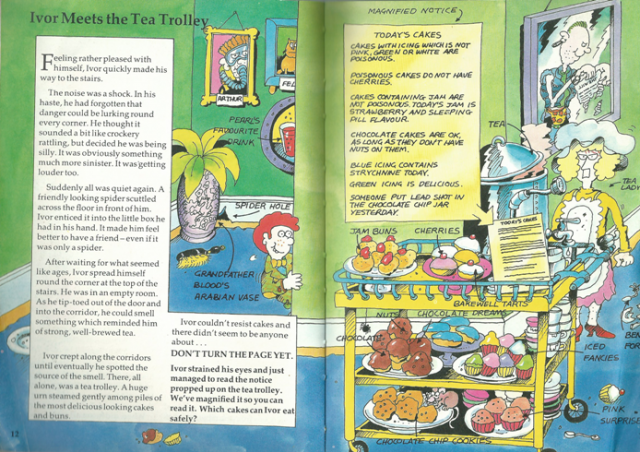
Ahh, this should hit the spot. I take back everything I’ve said about the castle, this is great. Tea and cakes? For this, I’ll overlook the way that the tea lady has an immense Hitler moustache. She’s dyed it white to disguise it, at least.
This page also sees the advent of the Friendly Spider, but who cares, cakes. I’ll… I’ll pass on the ones that have fallen on the floor or that the mouse has nibbled.
…Those are some pretty strange characteristics for cakes, though, even for Blood Castle. Why would they make poisonous cakes at all? I mean, maybe as a security measure, but then they put up a guide warning you about it right next to the cakes themselves! If they wanted to kill off the indigenous mouse population, they could just… get another cat.
This is a nice little logic puzzle, though. Let’s see. Pink, green, and white icing is fine; the lone purple, yellow, and blue cupcakes, along with the plateful of blue-iced cakes, are not. Wait, I had a blue-iced Doctor Who bun recently. It was strychnine! I’m for the chop!
The jam buns aren’t poisonous, but will put you to sleep, which I think counts as poison. The cherry cakes are… okay so long as they have cherries, so that’s three safe ones there, along with the four safe-coloured cupcakes. And the three visible chocolate dreams which don’t have nuts in them should be fine. Ivor has quite a few options if he really wants to hesitate in his vital quest to secure his legacy to pig out on buns. Hey, it’s par for the course; the tea lady’s stopped for a smoke or something…

Fifteen safe cakes? Three cherry buns, the four safe cupcakes, the three chocolate dreams… that’s ten, but what are the other five? The chocolate chip cookies are out, the jam buns are out, and the pink surprises appear to contain nuts, quite apart from there being four of them! What have I missed.
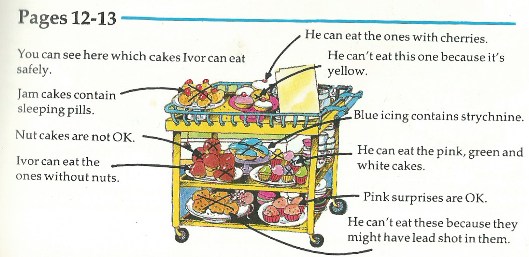
Oh. The pink surprises don’t contain nuts after all, I guess. I should have known, since they didn’t have a big label pointing to them reading “nuts,” but neither did two of the three nutty chocolate dreams, either. Also, one of the cherriless cherry buns was edible, too - fine, I’ll accept that. Well, Ivor, your big chance awaits! After all, if you’re the rightful heir, they’re really your cakes… right?
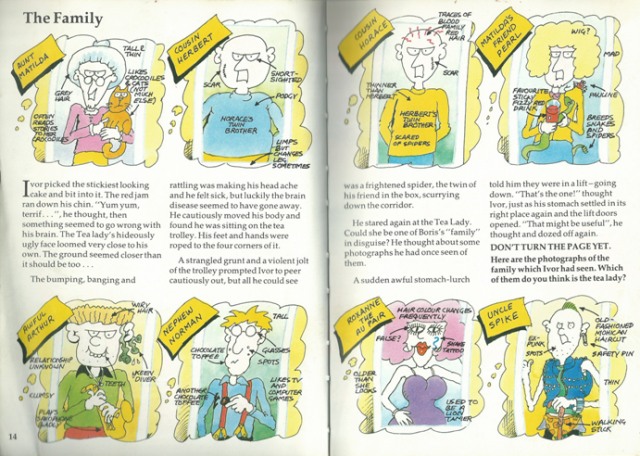
You moron, Ivor. You had one job! Don’t eat the poison!
It kind of seems redundant when the Tea Lady / tea lady / Tea lady could have just sprung out and grabbed him rather than waiting for him to be an idiot and eat poison, but hey-ho, now we have Ivor tied to a tea trolley and being wheeled along. I guess the tea lady just threw all the cakes on the floor to make room. Which, judging from the state of the carpet on the last page, is a common occurrence. But we don’t get to see an illustration of that, we get an illustration of Ivor’s freak show relatives. Which of them is the tea lady? Well, let me ask you this, why would they need to disguise themselves as a tea lady in their own house? Some… some kind of recreational reason? Well, whatever floats their boat, I guess…
It’s a fun enough puzzle, but the pictures should probably be ordered differently. You can basically ignore the bottom row, for instance, who bear not the slightest resemblance to the tea lady - the only one who’s even worth considering is Roxanne the au pair suffering a mid-life crisis, and that just because she changes her hair colour. Who is she the au pair to, anyway. Ivor’s the only child in the house, and he doesn’t even live there. It certainly isn’t Nephew Norman. More like Nerdy Norman, am I right? Ha! Ha! …Yeah, he’s basically us, isn’t he.
So what’ve we got. They’ve done a pretty good job mixing the tea lady’s features up all over the place. Matilda’s Friend Pearl is the closest fit and obvious answer and therefore not correct. Cousin Herbert is right out. Maybe there aren’t just clues in the pictures, though? There’s a clue in the text as well. This UPA is better at this than some of the later ones, I think.

This is one of those clues that basically gives away the answer. Although to be fair, those strands do look like someone just scribbled them on with biro, as they do on the portrait of the culprit. The book could just have been vandalised.
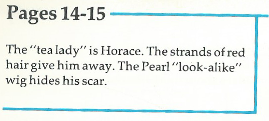
That’s not a very complete answer. You didn’t even mention the spider thing! Oh well. Let’s not pry. What you do or wear in the comfort of your own home is your business. Your and your weird extended family’s business.
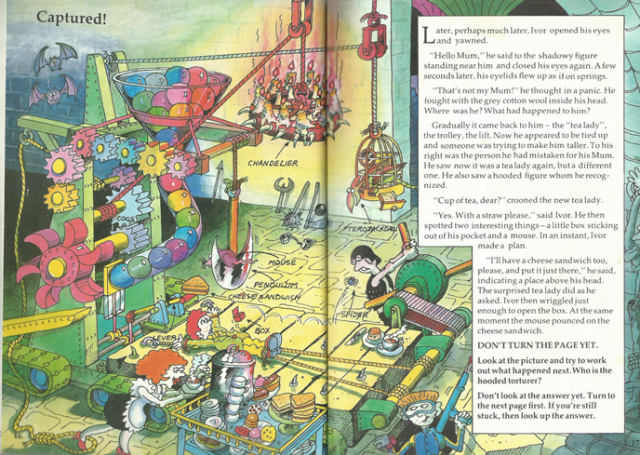
When you first look at this and read the first few lines, it looks an awful lot like Ivor mistakes a guy in leather and a black mask for his mother. Psychoanalysts, go nuts. But no, it’s the actual tea lady! So Horace really was just pursuing recreational interests? I guess it serves Ivor right for interrupting him. He could do with being a bit taller, anyway. He’s being pretty Intrepid about the whole situation, I have to say. He’s on the rack and has a giant blade swinging above him, and he’s taking tea with a straw. Watch out, James Bond and various other teenage superspies. Ivor’s like ten and he has outcooled you.
Also, lookit them cute bats in the top-left. Aww. Promotion to Pokémon, please.
I think the question of “Who is the hooded torturer?” is a way too easy question if you were able to answer the puzzle on the previous page, but I guess there’s no obligation to actually do so, and since the answer isn’t given to you in the normal course of events, you might conceivably not know. As to trying to work out what happens next, though - who can even tell what’s going on in this picture? It’s a giant rack with a weird redundant cog / ball pit mechanism attached. On tank treads. And as for “what happened next,” it looks like half a dozen things. Let’s take a hint to find out just what answer they’re looking for.

So a mouse the size of Ivor’s head is about to jump on him? It’s not just a rack, it’s a Room 101 re-enactment. But in all seriousness, the real heart of this puzzle is in what you’ll probably have done half a dozen times if you read many of these kinds of books at all: Cog-following. A.k.a. tracing repeated semicircles with your finger across the page. Quite a few things are going upwards, but one or two others are going down. Let’s hope they do so in the right places, or Ivor won’t be getting taller but instead considerably shorter.
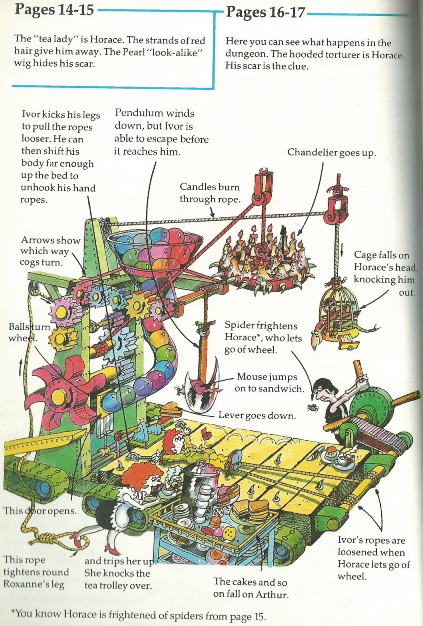
Good gravy! The answer is even harder to understand than the puzzle itself! What order are you even meant to read this thing in? …And more pressingly, how much of this could Ivor have even anticipated? It doesn’t look like he can see all of what’s going on with that machine from his prone position, so he might just as well have been dooming himself rather than saving himself. Maybe he really did just want a cheese sandwich?
…Even taking everything else into account, I’ve got no real reason why a bunch of cakes fall on Arthur. I don’t even know why he’s in this scene.
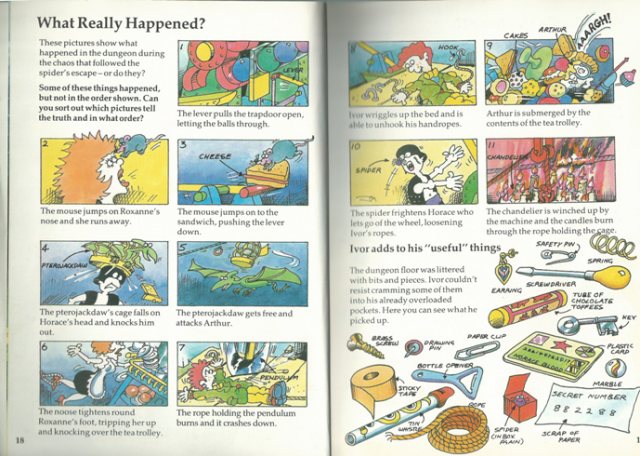
What Really Happened? Your guess is as good as mine, book.
This is a really odd puzzle in that it’s basically an extension of the previous one. It’s like they realised that a lot of what was meant to happen in the previous page was quite subjective and hard to be certain of, like the pterojackdaw’s cage falling on Horace or what happened to the tea trolley, but instead of making the puzzle clearer, they basically just set aside an extra double-page to account for it. Given the way the machine works, also, I’m not even sure if it’s meaningful to be able to say whether 6 happens before 11 or vice-versa. Or 7 versus 8. And 9 still seems pretty improbable to me!
I guess at least it’s pretty obvious that number 5 didn’t happen, though, since that would be totally unrelated to any decisions or effects you could have caused… no, the important thing here is all this junk that Ivor picks up. The inhabitants of Blood Castle seem to drop their important valuables at a moment’s notice whenever they’re distracted, like they’re in Dwarf Fortress or something, and so we have secret numbers and ID cards just left lying around alongside what’s either a small length of rope or a giant recorder.

Oh, three false pictures? 2 and 5 are out, I guess… is the other one 8? I assumed that that had to happen after Horace was knocked out in order for Ivor to get free at all…

Haha, I didn't always scan these pages wonderfully well... but anyway. That answer is… really kind of petty, you know! 7 didn’t happen because Arthur had already escaped? Really? Actually, there is a mistake in 7, which is that the rope holding the pendulum isn’t the one that burns… but that’s not the answer as they give it! I’m not even getting onto riddling out the “true” order of events. Yeah, this was a dud, let’s just move on…
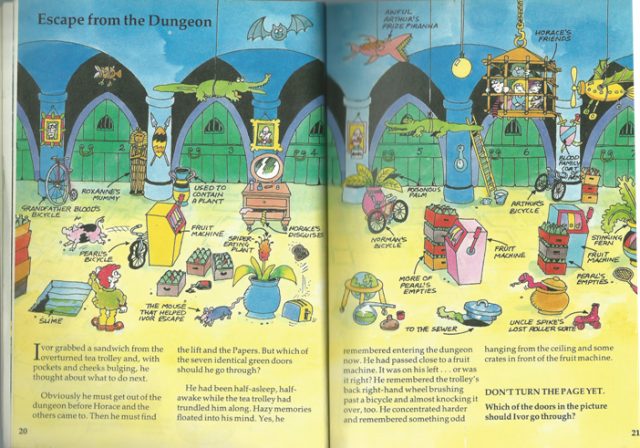
We may not be escaping from Blood Castle yet, but at least we’re escaping from somewhere.
I wonder what definition of “come to” Ivor is working under. Horace was knocked out, sure, but Arthur was just knocked over, by a bunch of cakes, and Roxanne is suspended in mid-air. Arthur could be after him in a flash. Unless he’s hungry. Or like one of those OCD vampires and witches who you can defeat by throwing rice on the ground, and they have to count every grain.
Here we have a puzzle which depends upon every single one of Ivor’s weird relatives having similar interests. Apparently they’re all pretty fond of cycling. I guess Tebbit’s instruction to get on their bikes and look for work really affected them, even though they’re upper-class. …Maybe they spent it all on drink and gambling, judging by the fruit machines and “Pearl’s empties.” That’s slightly depressing. Let’s move on to the puzzle instead. I can pretty much guarantee you that the hint will be about stuff being on the right when you enter the dungeon being on the left when you leave.

This is the one they think’s so easy you don’t need a clue? More like “we couldn’t think of a clue.”
At any rate. The correct door is near to a fruit machine, has a bicycle on the right a.k.a. left, has something odd hanging from the ceiling above it, and has crates in front of the fruit machine a.k.a. behind, and that last clue is literally the only one we need and it’s door number five. So confident I’m not even going to check the other clues.

Yep.
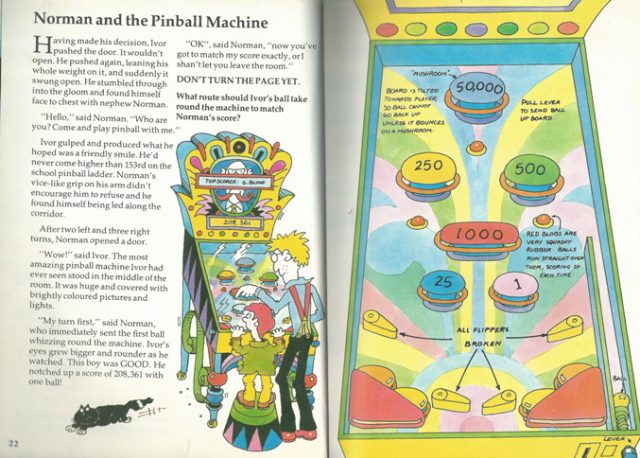
Welcome to the stupidest puzzle in the entire book. Maybe the entire series?
It sounds kinda like Nephew Norman doesn’t get out much, but we could probably have guessed that anyway, judging from the stereotype. He doesn’t even know who Ivor is, whereas everyone else is dedicated to stopping him… either that or everyone else spends their time watching out for intruders to torture and/or offer tea and sandwiches to. Not implausible, come to that. Ivor seems to have pretty low standards for “the most amazing pinball machine ever seen,” but as such a low-ranking pinball competitor, he probably hasn’t seen the best the sport has to offer.
So this puzzle requires us to use logic and mathematics to solve a game of luck. We have to add up to 208,361 with the numbers given on the board, which is fine, and plot out how this could actually happen, which is silly and ridiculously subjective. If we want to create a make-believe route of how to add up these figures we could come up with nearly anything, and there’s no way of knowing what the artist expects or thinks is plausible. So… just treat it as a maths puzzle, and forget the nonsense about the route.

What does that even mean? Well, it does mean something, which is that to do the addition right you need to work out mildly plausible interactions of the ball between mushrooms. So if you need to hit the 50,000 mushroom several times, you need to ask what it’s rebounding off to hit it the second time, third, and so on. But again, what is “mildly plausible”? Best just to ignore it.
At any rate, if you’re going to solve this mathematically, you probably want to break the whole equation down into chunks. How do you get 200,000? 8000? 300? 60? 1? Pretty much the only way the 200,000 is getting completed is with four strikes of the 50,000, as any less would require you to hit the other mushrooms tens of times. The 8000 is by extension a matter of several 1000s and a few 500s on the way. The 300 needs to involve at least one 250, and then a few 25s to make up. Add a few 10s from the red blobs wherever you like and finish up with 1. The clue pretty much gives us 50,000 times four and 500 times three, which makes 201,500 to start with. If we then assume a few rebounds between 1000 and 250 and subsequently between 1000 and 25, then maybe 205,250 and onto 208,350, rebound off the 1, say that it hit one of the red blobs after the fourth 50,000 to make up the 10, and the solution as traced on the board will be a real mess.
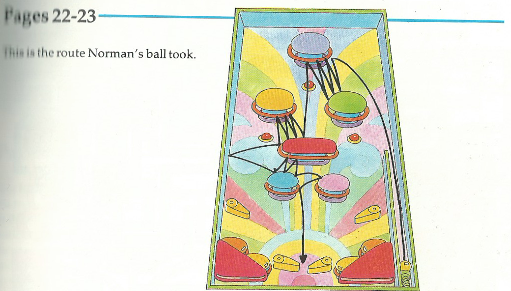
I’m going to be perfectly honest and say that I remembered that bizarre last bounce off the 1000 then off the side and back over to the 25, because expecting you to guess that is pretty silly. My outrage was such that it has stuck in my mind for countless years. I mean, really. This is absurd. How are you supposed to solve this logically? And, come to that, how is Ivor meant to not only do so, but match it perfectly by chance? I guess, to be fair, that last bit is Norman being unreasonable, not the book, but there’s a fine line between something a character in a book does and something the author of that book does. A fine line as in no line.
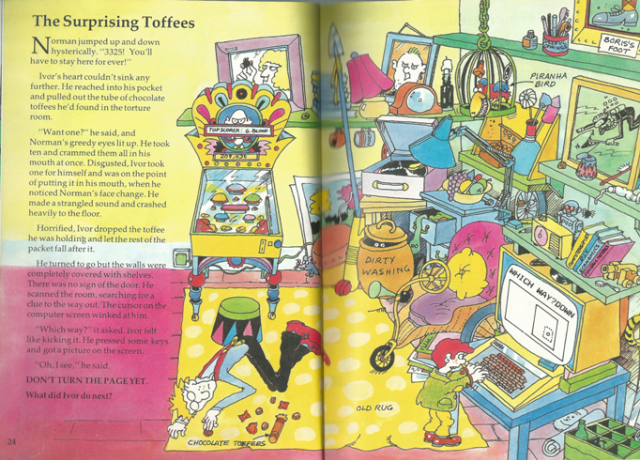
Which is probably why Ivor poisons and kills Norman to escape. Real Intrepid there, Ivor. Was your inheritance really worth becoming a murderer?
In other paradoxical news, Ivor entered the room through a door and now there is no door. Further evidence of his disturbing descent into insanity? Yes. Or maybe this is just a really odd page. There’s the poisoning, there’s three-quarters of the room being cluttered with stuff and the rest totally empty, there’s the odd selection of books, the dodgy perspective on Ivor in relation to the computer desk… and then there’s the puzzle, either the hardest or the easiest in the book. Basically, the vast majority of the huge quantity of stuff on this page is a distraction, but it really brings home how chaotic and detailed the art in Escape from Blood Castle is. Graham Round must have been exhausted by the end.
I remember the solution to this puzzle, so it’s honestly no challenge to me, but I wonder if it’s quite so obvious to everyone else. Well, everyone else when they were ten or so. I can easily see how it might leave you totally stumped.

Uh, what? How is that a clue? That’s basically the answer to the whole puzzle, minus maybe another sentence at the end!
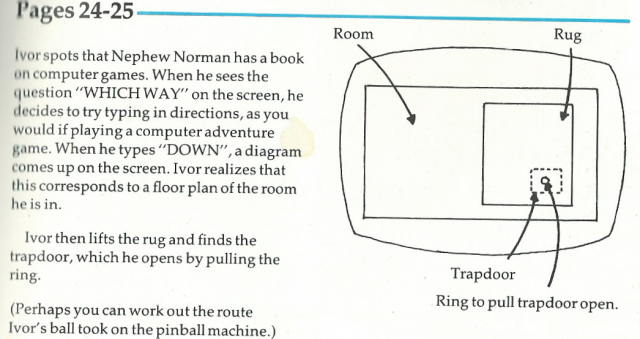
Computer adventure games have moved on a little way since 1985, I think. But let’s just be distracted from that by the decision to add an extra puzzle in at the end of the answer, apropos of nothing, as if we don’t have enough to do. Classy. 3325? Eh, three 1000s, one 250, and three 25s, and good luck working out how he pulled it off.
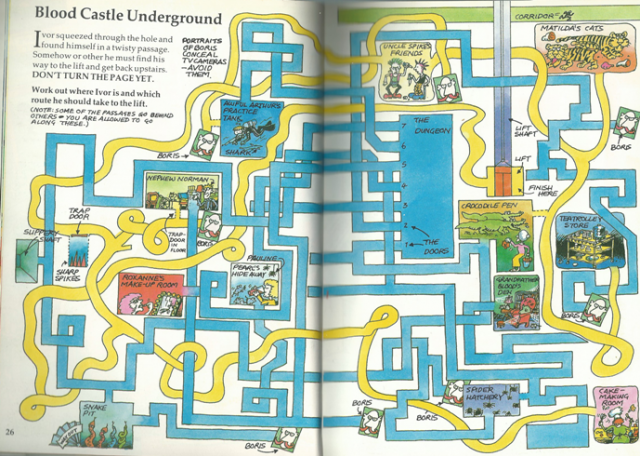
It’s been too long since we’ve had a maze, so who cares about the plot, put a maze in already! This is the thinking behind this page. It is a really nice maze, though.
Working out where you are is easy, because the previous room is literally drawn right on, along with Norman, now thankfully resurrected and none the worse for wear aside from his legs having been chopped off. Getting to the lift is ridiculously easy, too. I think maybe this puzzle is meant to be harder - that you’re also meant to trace the route from the dungeon to Norman’s room. Slightly easier if you turn back a couple of pages and read that he took two lefts and three rights from door #5. …Wait, even then there’s only one real branch, so it’s pretty much a straight line. Good gravy, this entire page is basically a huge red herring! I take it back, this maze is terrible.

Apparently there is something redeemable about the maze, though? Hmm… is it that Matilda’s cats are feasting on human flesh? Oh, so that’s where Norman’s legs went.
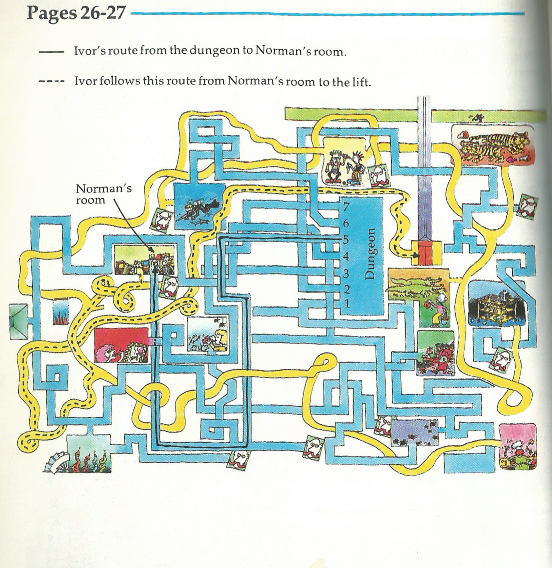
Weeeeeeeeeeaaaaaaaaaak.
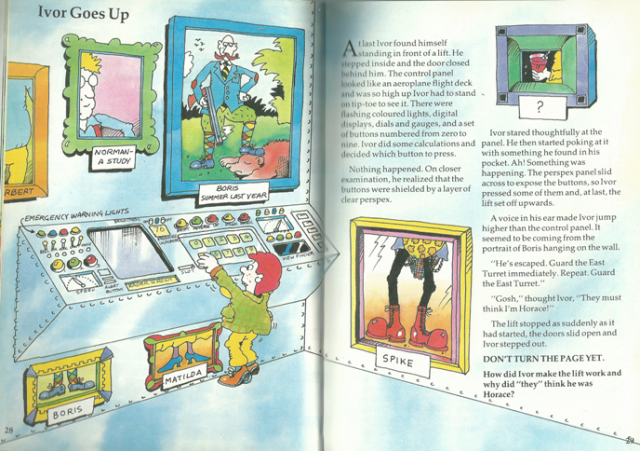
The book doesn’t make too wonderful a case for the villainy of Ivor’s enemies - idiocy, sure, but not villainy - but here we have a framed picture of Boris murdering protected species. Charming.
It’s been a long, long time - too long - since I’ve read Charlie and the Great Glass Elevator, the little-known sequel to an extremely well-known book about a confectionery manufacturer. But this reminds me rather a little of it. Silvery, high-tech, buttons everywhere that might mean anything. Think of all the puzzles you could construct out of this page - there are so many possiboh it’s really easy and has nothing to do with the elevator and the buttons mean nothing. Or I don’t know, maybe it’s the kind of puzzle you either solve immediately or get horribly stuck on?
The answer isn’t on this page, so that doesn’t help. You have to leaf back a bit.

Oh, okay, to be fair I had forgotten about the second thing, but thing #1 is pretty easy. This is actually a very video-game-y sort of puzzle. Not even worth giving the answer here, I’d just be parroting the book.

It’s never described as a credit card on the page, incidentally. I can see why - what the narrator tells you, we implicitly regard as trustworthy, so if the card was labelled as a credit card, we might never even consider that it could be something else, which is a keycard. …Wait, so does this elevator only have one destination?

Ivor arrives on a roofscape that quite frankly looks more like some sort of industrial wasteland - a flat and empty wilderness littered with abandoned equipment and Mario-style pipes. Yet another map shows up, with incredibly convenient timing. What are the chances of that. The answer is 100%, where a puzzle is involved.
Kind of an odd puzzle, though. The map is slightly stylised, so while you can figure out the arrangement of objects, the turret orientations aren’t shown. For some reason, abandoned ladders, of which there appear to be an unlikely number, are such a permanent fixture as to be drawn on the map, but we can trust the orientation of those, strangely - was this map only drawn a few minutes before Ivor got it? Maybe it was drawn by the same “source” who tipped him off about the Papers, Dr. Plothole. Chimneys are drawn on, but the style they’re drawn in on the map doesn’t fit their appearance in real life - except for one, oddly enough. You’d think they’d at least show whether they’re double or triple chimneys.
This puzzle probably depends a lot on your spatial reasoning skills. If you can picture yourself in Ivor’s place, looking in each direction and how things on the map would show up from that perspective, then it’s fairly easy, although I think it’s not a wonderful puzzle in the first place - I don’t know if it’s ambiguous enough. Maybe that’s because I caught the giveaway clue by accident earlier, though.

Why exactly would that be drawn on the map, though? Is it implying that only one of these chimneys actually functions? If I’d been working on this puzzle, I think I’d have done some finagling with a weathervane, myself…

If they’re drawing the ladders on, they might as well add the birds, mice, spider and snake. They’re on the other official maps, after all! Also, is it me or is half of this answer more like a clue. You’re not here to justify the answer, just tell us what it is! Or if you are going to justify this answer, go justify all the other silly solutions as well…
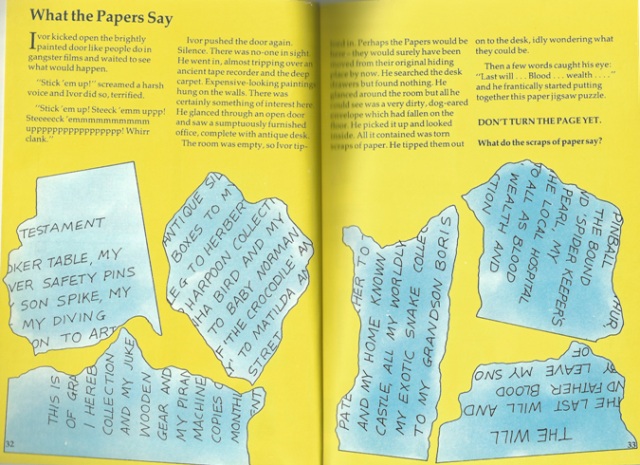
So now Ivor’s playing the aggressor in a gangster movie… and immediately failing in his role. He’s the worst trespasser ever. Fortunately, he’s matched with the worst defence system ever, one which doesn’t actually repel people but instead orders them to stay put. Ivor, you truly are a member of the Blood family.
(Incidentally, What the Papers Say is the name of a long-running satirical newspaper review show on the radio in Britain, which is kind of an odd outside reference for a kids’ puzzle book until you remember that The Dark, Dark Knight would later make a jokey reference to a Nazi purge, so this is anodyne by comparison.)
Kind of surprised that we haven’t had a jigsaw puzzle yet in this book, as they’re another staple. Also not really very interesting to solve in this Let’s Read format, even if it would be easy, because you all know that the full answer is going to be extremely readable so there’s no point me typing it all out again. Oh the irony, this would be more interesting on video. Well, on the off-chance that you don’t do jigsaws very often: Start with the corners and edges… although this one has a slight twist in that regard. One of the edges isn’t a proper edge. That’s actually clever.

Make sure you don’t cut the pieces out of the page to stick them together, that would be vandalism. It’s probably not that hard to just read in your head, though?
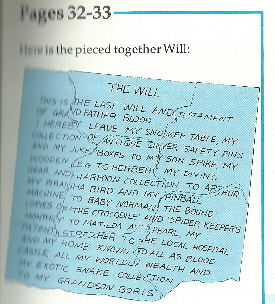
Huh, well what d'you know, it really isn't all that legible. I prbably should transcribe it. ...Nah, you only need to read the last line. Wait a minute - so the true heir was… gasp! This turns everything on its head! Ivor really is the villain of this book! And as such from now on is to be known as “Insidious Ivor.” Or maybe “Incompetent.” That might be better.
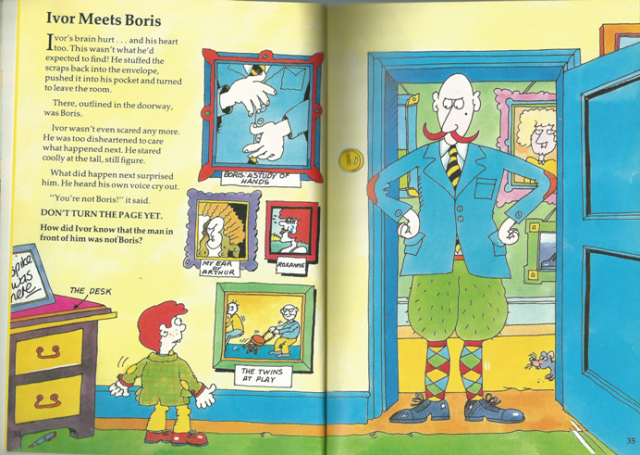
Title of the page: “Ivor Meets Boris.” Text on the page: “You’re not Boris!” This is false advertising.
It’s a fairly pure puzzle we have here. There’s very little information presented on the page, so you don’t have much to go on in diagnosing the truth of Ivor’s statement. This is one of those times which I find quite satisfying, where the real answer to the puzzle can partly be found by going back through previous pages of the book - it makes the story feel more like a complete product… but there’s a nominal answer you can find just on this very page. Not a very good answer, though.

Boris has one particular distinguishing feature which I quite admire, and yet this figure doesn’t seem to have it. Did Boris have not time enough to complete his usual daily preen before overhearing Ivor weeping in the office? Or is there more to it?
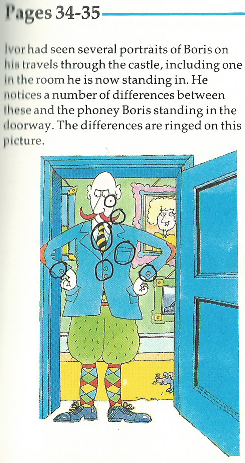
Aha! Now we get to the truth of things. This Boris is lacking that extremely dashing twist of the moustache, and nor is his mole on the same cheek. You can make an argument about the moustache all you like, but unless all of Boris’s portraits have been painted in a mirror, we’re looking at an impostor! …Not a very good impostor, mind. Boris has so few distinguishing features and the impostor managed to get both of them wrong. Wow, this whole family is incompetent.
Note also that the book seems to think “the impostor is wearing different clothes” counts as a reason why he’s not the real deal. You’re telling me Boris wore exactly the same outfit every day? Seriously? Because most other members of the Blood family have been seen in multiple costumes just for the duration of this book…
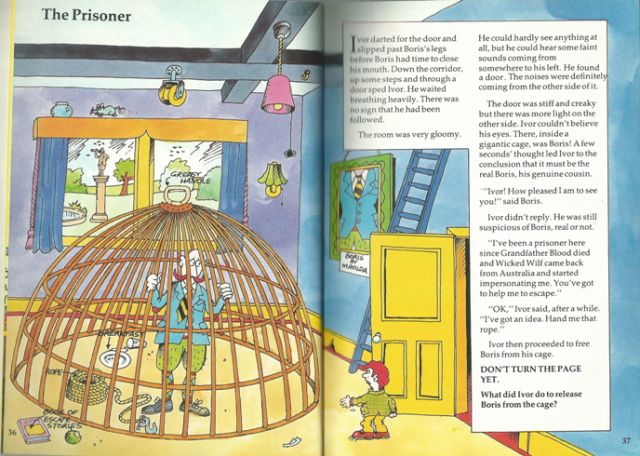
The complex and mysterious backstory for this narrative is thus unfolded: “Wicked Wilf came back from Australia”. Magical stuff. What a deep and rich history this narrative has, and I for one can’t wait to Let’s Read the prequel about why Wicked Wilf was sent to Australia in the first place. Deported, maybe. Also I guess being stuck in a cage is why Boris hasn’t been able to change his clothes. So are all the family in on Wicked Wilf’s scheme? Because, so far, zero wickedness has been perpetrated on-screen by Wilfris. I think they’re all just crackerjacks. Even Ivor’s a murderer. Maybe Boris is better off locked up.
As to how Ivor released Boris… well, there are a few clues here. A ladder, pulley, greasy handle, a length of rope with a hook attached… why exactly is that allowed within the cage, anyway? Did Wilf hope that Boris was going to hang himself or something? From where he stands it looks like Boris could easily have used the hook to break a window or something, maybe called for help. Oh well. But I will be assigning bonus points if the means of Boris’s escape are something he could have effected himself.

Oh, oops, I gave away the clue! Like they’re difficult to spot, though. The illustrations seem to have been getting considerably less chaotic recently. I guess Mr. Round was getting exhausted… physically and creatively.
So I’m guessing Ivor props the ladder up between the cage and the wall, runs the rope through the pulley and hooks it over the greasy handle, and then he and Boris join forces to pull the cage up, right? That seems pretty reasonable. I genuinely don’t remember but have a suspicion that there is a stupid twist.
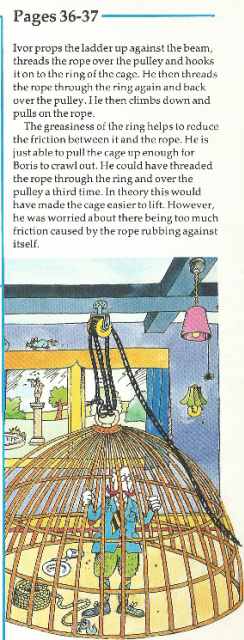
This answer has entirely too much in the way of plausible physics for me to accept. We’re really meant to be worrying about rope friction here? In a book which tells us that wearing a different jacket makes you an impostor?
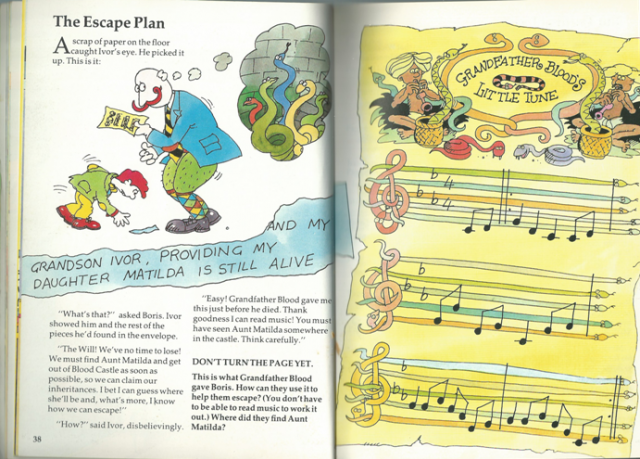
Suddenly the author realises that they’ve only a few pages left and have to get things wrapped up, so look, the Will’s destroyer left a crucial fragment right next to an imprisoned enemy who would happily make use of it. On the plus side, the title “Escape from Blood Castle” is finally relevant!
Also suddenly one of Ivor’s evil relatives is, we must presume, happy to actually help out for once. Maybe the family simply have no will of their own and do whatever Boris says, even if it’s “put a child on the rack, but make sure he’s well-fed when you do so.”
It’s another one of those puzzles where you have to go back through the book! Partially, anyway. We need to not only remember what Aunt Matilda looks like but where we’ve seen her in non-portrait form. After that we need to turn back through the book again to remember how we’re meant to use this other convenient plot device - honestly, everyone just leaves these vital bits of paper lying around in this castle.
Do you know how our heroes(?) can escape? Hint: You would be just as able to complete the puzzle if the right-hand page didn’t exist.
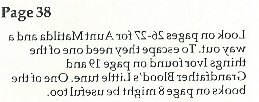
Is this really a clue? It flat-out tells you where you need to go and what you need to look at to solve the puzzle, it just doesn’t give you the answer. Even though it might as well if it’s going to go that far. …I can’t read music, but is the tune actually any good?

Hey guys, in case you hadn’t noticed, there’s a snake pit in Blood Castle. Snakes snakes snakes snakes snakes. Remember, snakes are important!
Snakes!
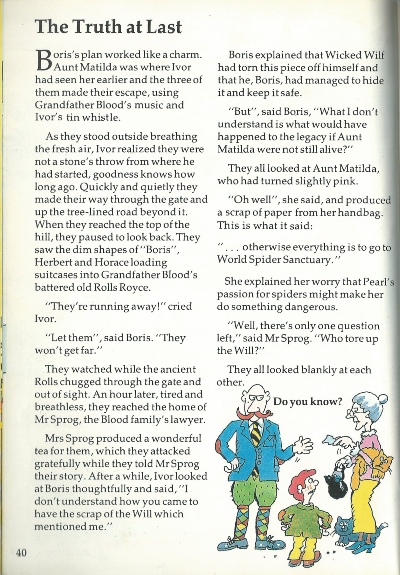
And the triumphant and eponymous Escape from Blood Castle, the fulfilment of all the promise of the title, takes place off-screen right before the last page of the book. Could there be any more fitting conclusion. Yes there could, and that’s combining it with hasty wrapping-up of all the plot holes, I mean loose ends. It’s a good thing there’s only one question left!
Wait, what. That’s not right. There are loads of questions. Like, who in the family was in on Wicked Wilf’s deception and who wasn’t? Why were Herbert and Horace working with Wicked Wilf and not anybody else? What’s the point of Herbert being one of the villains when he never actually appears in the plot? Why were Roxanne and Arthur helping out with Ivor’s interrogation if they weren’t part of Wilf’s plot?

If Aunt Matilda had hold of the Will at one point and was able to tear part off herself, why didn’t she keep the rest safe and make the case for Ivor’s inheritance? Why did Boris say that Wilf, Herbert, and Horace wouldn’t get far when there’s nothing stopping them from getting far? Why were they escaping when as far as they knew they had won and just needed to recapture Ivor again? Why didn’t Wilf chase after Ivor after his deception was discovered? Is Norman okay or is Ivor technically a murderer after all? Why didn’t the Blood family lawyer have a copy of the will or an awareness of its contents so that he could grant Ivor his inheritance? Why

Hellin’ right I’m wondering why. I’m not sure that even makes sense. And speaking of not making sense, what’s with that pinball puzzle, eh? What made you think that was a good idea? And - hey, where are you going? I’m not done ranting yet! I’ve still got things to say! Wait! Come ba
TUNE IN NEXT TIME FOR MURDER ON THE MIDNIGHT PLANE
To recap, Usborne Puzzle Adventures are still puzzle adventure story quiz drama comedy books for young lads and lasses who like puzzles and like stories but were born before the Harry Potter children’s literature renaissance. Also for individuals with genius-level intelligence as sometimes these puzzles only make any sense to the person who wrote them, and oftentimes are kind of shoehorned in because, help, we’ve reached the end of another double-page spread but haven’t packed in the full puzzle quota yet! But this is part of their charm. The silliness of the puzzles goes along with the silliness of the plots, and here we have a fairly silly early entry in the series - the earliest, in fact. Escape from Blood Castle, the very first Usborne Puzzle Adventure of them all. As ever, by which I mean “as twice before,” I’ll be pairing each puzzle up with its designated Clue and then revealing the official Answer, and then I will criticise both.
Normally I’d show you what the book looks like, but this time it’s a bit different…

I mentioned before that I used to own the first three, in fact, UPAs in a compilation volume, and this is it, discovered in an ancient box when I moved house. We’ve already done one of the books in this volume - The Curse of the Lost Idol - and there’s one more included, so we’ll be reading more of these Solve Your Own Mystery Stories, so the protagonists don’t have to. This rather inept omnibus doesn’t give proper copyright details or authorial credit for the three individual books, but thanks to the wonders of the Internet I can tell you that this was published in 1985 - nearly thirty years, wow, it honestly doesn’t feel quite that old - and will set you back nearly two hundred pounds if you want to buy it online, so it’s a good thing I dug it out of my loft so I can skim some suckers on Amazon Marketplace (yeah, like anyone ever buys those extortionate second-hand editions). The author of Escape from Blood Castle was Jenny Tyler and the book was designed and illustrated by Graham Round. You have a lot to answer for, you two.
Let’s Read the back cover.

“challenging but not impossible to understand” - well, we’ll see about that… actually, by modern standards this is kind of an odd back cover, in that it offers not so much a synopsis as a description of how the books are constructed. Perhaps, judging by the review from Books For Your Children, it’s actually aimed at parents, as it’d be a bit weird to have that as your go-to puzzle book source as a child, and I’m not sure if kids in the eighties could scrape together the shekels for such an exorbitant payout as £4.95. (ThisIsMoney.co.uk tells me that that would be £10.92 in today’s terms! That’s $17.76, American readers, credit of XE.com. I am all about the attributions today.) Anyway, I suppose we get a good enough idea of what to expect from the plots by the titles given, not to mention the illustrations. Candy, maps, and spiders. Everything you need to write an Usborne Puzzle Adventure. Behold the bafflement of Escape from Blood Castle…
Oh, and I’ll let the omnibus introduction take us through the rigmarole of how this thing reads. Again. Like we needed to hear it twice. Sometimes these books assume you’re quite dim, but other times they seem to expect you to be a genius.

I kind of think these intros are written in-universe, too - in a world where writing hints in mirror writing is genuinely special and cryptic and not something that can be identified at a glance. Figure out how to write backwards, and you’ll confound the police, if not an eleven-year-old trespasser. Well, it was for kids. Well, no, it was for kids to make them feel smart. Apparently it didn’t work, as later on they stopped writing the hints backwards and just presented them normally… I don’t know if the puzzles were hard for the readers these books were aimed at, but I dare say I couldn’t have done them, since I didn’t exist at the time, so fair enough. Oh, that’s Blood Castle down there, by the way. Spoilers!
But now for something a little more specific. Say hello to our brave and totally believable hero:

Ivor is Intrepid, and he wants Papers. There are no useful stationers’ nearby. The newsagent has shut down. Infiltrating his relatives’ castle is all he has. That’s the backstory of this book, more or less, and you really shouldn’t question it because it makes less sense as the storystory goes on. This book is considerably goofier than subsequent entries, which at least tried to pretend that its gormless protagonists were crudely-drawn everypersons existing in a world like yours or mine back in 1985, assuming you had been born or were capable of reading by then. Readers who were children in 1985: Did you have patches sewn onto the elbows of your jacket, and make friends with spiders and mice? I know it was a poorer time, so I guess I’ll believe anything. Still, though. Sweet moustache there, Boris. You should probably see a doctor about those ears, though.
Okay, this is meant to be a puzzle adventure, let’s get on with some puzzles. Some official puzzles, rather than just the mysteries of 1980s culture.

Escape from Blood Castle begins with us trying to enter Blood Castle. Ivor, did you even read the title?
But this is new - or rather, old. Whereas the previous two UPAs I pagescanned - one of which came literally right after this - had plotty intro double-pages that set up the story, this one throws us into a puzzle straight away. Good on you, Escape from Blood Castle.
Whoa, though, that illustration! Look at all those labels - what is this, a bad political cartoon? I think we know sharp spikes, drain pipes, and barbed wire when we see them. Maybe not tame crows, though, which apparently have different-coloured beaks to wild crows. Must be a shiny version. But no, we mustn’t get distracted - we have to help Intrepid Ivor continue to be Intrepid or his friends will never let him live it down. Apparently being Intrepid means sneaking into a relative’s run-down manor house while wearing his favourite Eleventh Doctor cosplay that he learnt of from the man himself using time-travel. Oh, but he’s being cheated out of his wealth and title by said cousin! That changes things - big things, like the laws on breaking and entering. Ivor’s friends don’t sound very sympathetic to his plight, though, if instead of joining him on his quest they’re planning to mock him if he funks it. Must be at private school. Where there’s every reason to be afraid when the older boys start talking about funking things.
It’s a pretty good puzzle by certain standards, though. You have to read the text and the illustration in detail to know everything you’ve got to work with. And the Ekans Tip gives us the perfect tool we need to prepare for the obligatory clues, which to be fair you might need, as you can never be sure how creatively you’re meant to be interpreting these illustrations…
Let’s once again debut the Clues page…

I think that it would’ve been funnier if they’d printed SNAKE PIT the right way around in the mirrored clue, since it was already mirrored. But anyway, this tells us what we need to know, and that is that the key to one’s problems is always, always a literal one. In puzzle books, anyway. They aren’t very good at being cryptic, despite, you know, puzzles.
I won’t spoil the answer to this one, but I’m pretty sure I have it right - or have remembered it. It involves nylon thread, a bloodstained hook, and poison ivy.

Uh, my apologies for the image quality; it looked better on my computer. So, that solution… wow, that was more complicated than I thought. I figured he’d climb up the ivy, brace himself at the top of the lower drain pipe, and try and fling his grappling hook upwards to snatch for the key. Really, climbing up to the roof and sitting on a narrow ledge on a building with crumbling masonry is meant to be the safer option?

Years later, this map is my abiding memory of this book. I remember learning the word “adjacent” from this puzzle. I mean… just look at that thing. Wow. It’s overwhelming. What’s nice is that the far-left side is totally consistent with the previous pages! What’s not nice is that there’s no actual way to enter many of the rooms, including the Look-Out Room, Turret Room, and Black Hole. Well, I can see why you might want to avoid a Black Hole…
What we have here is actually a double puzzle, where later Usborne Puzzle Adventures might be content to have just one. You have to use the textual clues to figure out first where Ivor is, which is kind of hard, and then use the text to figure out where he wants to be, which is kind of easy once you learn the word “adjacent.” It’s a really strong use of text-picture interaction, and you rarely see it quite this deep, in my recollection. I’m very fond of this map. There’s just so much detail in there, and I really admire the effort.
Once you understand the terms the book is working under - walls are rough and doors are smooth, apparently - and especially so long as you remember where you’re meant to be starting from, picking up on Ivor’s present location becomes simple. As for where he wants to be, though - that’s tougher to narrow down because there are so many places to look through, and I think it may have been difficult enough for me whenever I first read this book that the solution is now seared into my brain (or at least, I can’t help thinking about it whenever I use the word “adjacent” - wow, I’m broken). But it’s actually more or less where you’d expect. Still, do we at least get a hint?

Smooth areas being doors is probably the least intuitive part of the puzzle… but even if you didn’t understand that, it’s not really necessary to do so to solve the riddle. No clues on where Ivor should be going, though? As to how he gets there… well, as on any maze, it’s always the most winding, unintuitive route possible, so you don’t run into random zombies, cavemen, and tea ladies.

Voila. It’s a good thing Ivor’s map tells him the fixed and immutable positions of the bizarre monster wardens.

To the library! Not that this page actually tells you that it’s the library. As it said in the intro, you need to solve the puzzles to understand what’s going on - to a certain extent. It’s more that it doesn’t resolve the cliffhangers.
Lot of fire in here for a library, though. And… abandoned afternoon teas. I get the feeling Cousin Boris doesn’t pay the servants enough. Maybe they locked Ivor in under the belief that they were offing an obnoxious relative - a sort of Gormenghast thing, you know. Bad luck on the old Papers business, Ivor. Should probably have put your faith in a better source than an anonymous non-character we never meet or hear of again.
There’s a fine line between a cartoonist’s captions and the title on a book’s spine, and this page crosses it, I fear. Golly, though, I just can’t figure out what the riddle is to those books, despite mirror writing being a staple of this puzzle book so far. Let’s look for a hint, they’re easy to read.

“Code” is laying it on a bit strong there, especially to read the hints you have to decode them in exactly the same way! The real code is whether you’re also meant to read the second line first. “Spiders Keeping” doesn’t make a great deal of sense as a title, but then again, neither does “Poems Nasty”…

Oh, so the bookcase is also full of spoilers? Burn them immediately. …Somehow. The books on the lowest shelf appear to be larger than Ivor himself. Good luck pulling the handle, mate. You’ll need it.

Do not adjust your Internet. I have not accidentally pasted the last-but-one double-page again. It’s different. …Slightly.
To Graham Round’s credit, close study suggests to me that he literally redrew the whole thing - it’s not a copy-paste. I mean, yeah, sure, the effect is of a virtual copy-paste, and obviously referencing and tracing were involved, but it all appears to have been redone from scratch, judging from some of the finer details on things that aren’t meant to be different - the linework on individual doors…
It must be said, spotting the differences can be quite fun. Some of the changes make the map look more like it’s simply the same place, only later - the zombie near the entrance has moved on, for instance… in fact, wherever there’s a living thing, it’s moved from the first map or has only just appeared. I’m not quite sure why an official map of the household shows someone approaching a door, for instance - I almost wonder if the brief for this page changed at some point. But really, it’s just flavour. And it still looks great.
As to the essential puzzle itself… well, it’s a tricky one. Very finicky. I honestly don’t remember the answer. And I think it more or less depends upon your interpretation of the words “to its left.”

Well that’s, uh, very interesting, but it doesn’t really affect the puzzle itself…? Great hint there. Is it really a hint if it has nothing to do with the answer?

Wait, what. That’s the answer. The two floors of the house are identical save for a few bits of furniture? Right down to the same people being present but having moved slightly forwards? And how does this equate to Ivor knowing that he was in the wrong room when the right room has literally exactly the same characteristics as the one he was just in? How can his map show “the wrong floor” when he’s just trying to navigate around the house and the map is simply a tool for doing so and when he has no idea which floor hosts the right room? And when, furthermore, the right floor looks identical to the wrong floor? This makes no sense.
My solution was that one of the maps was just flat-out a forgery, but that regardless Ivor was meant to go to the Little Room, in which the bookcase is on the fireplace’s left, as described in the original instructions - in the Library, the bookcase is instead to the left of the fireplace. Is that too subtle a distinction? It feels like less of a trick question than the actual answer, let me tell you.
Wow. I didn’t remember that at all. I did remember always being confused between the Library and the Little Room. Maybe I never looked at the answers too hard for this bit. I need a break now. A little light refreshment. So too could Ivor…

Ahh, this should hit the spot. I take back everything I’ve said about the castle, this is great. Tea and cakes? For this, I’ll overlook the way that the tea lady has an immense Hitler moustache. She’s dyed it white to disguise it, at least.
This page also sees the advent of the Friendly Spider, but who cares, cakes. I’ll… I’ll pass on the ones that have fallen on the floor or that the mouse has nibbled.
…Those are some pretty strange characteristics for cakes, though, even for Blood Castle. Why would they make poisonous cakes at all? I mean, maybe as a security measure, but then they put up a guide warning you about it right next to the cakes themselves! If they wanted to kill off the indigenous mouse population, they could just… get another cat.
This is a nice little logic puzzle, though. Let’s see. Pink, green, and white icing is fine; the lone purple, yellow, and blue cupcakes, along with the plateful of blue-iced cakes, are not. Wait, I had a blue-iced Doctor Who bun recently. It was strychnine! I’m for the chop!
The jam buns aren’t poisonous, but will put you to sleep, which I think counts as poison. The cherry cakes are… okay so long as they have cherries, so that’s three safe ones there, along with the four safe-coloured cupcakes. And the three visible chocolate dreams which don’t have nuts in them should be fine. Ivor has quite a few options if he really wants to hesitate in his vital quest to secure his legacy to pig out on buns. Hey, it’s par for the course; the tea lady’s stopped for a smoke or something…

Fifteen safe cakes? Three cherry buns, the four safe cupcakes, the three chocolate dreams… that’s ten, but what are the other five? The chocolate chip cookies are out, the jam buns are out, and the pink surprises appear to contain nuts, quite apart from there being four of them! What have I missed.

Oh. The pink surprises don’t contain nuts after all, I guess. I should have known, since they didn’t have a big label pointing to them reading “nuts,” but neither did two of the three nutty chocolate dreams, either. Also, one of the cherriless cherry buns was edible, too - fine, I’ll accept that. Well, Ivor, your big chance awaits! After all, if you’re the rightful heir, they’re really your cakes… right?

You moron, Ivor. You had one job! Don’t eat the poison!
It kind of seems redundant when the Tea Lady / tea lady / Tea lady could have just sprung out and grabbed him rather than waiting for him to be an idiot and eat poison, but hey-ho, now we have Ivor tied to a tea trolley and being wheeled along. I guess the tea lady just threw all the cakes on the floor to make room. Which, judging from the state of the carpet on the last page, is a common occurrence. But we don’t get to see an illustration of that, we get an illustration of Ivor’s freak show relatives. Which of them is the tea lady? Well, let me ask you this, why would they need to disguise themselves as a tea lady in their own house? Some… some kind of recreational reason? Well, whatever floats their boat, I guess…
It’s a fun enough puzzle, but the pictures should probably be ordered differently. You can basically ignore the bottom row, for instance, who bear not the slightest resemblance to the tea lady - the only one who’s even worth considering is Roxanne the au pair suffering a mid-life crisis, and that just because she changes her hair colour. Who is she the au pair to, anyway. Ivor’s the only child in the house, and he doesn’t even live there. It certainly isn’t Nephew Norman. More like Nerdy Norman, am I right? Ha! Ha! …Yeah, he’s basically us, isn’t he.
So what’ve we got. They’ve done a pretty good job mixing the tea lady’s features up all over the place. Matilda’s Friend Pearl is the closest fit and obvious answer and therefore not correct. Cousin Herbert is right out. Maybe there aren’t just clues in the pictures, though? There’s a clue in the text as well. This UPA is better at this than some of the later ones, I think.

This is one of those clues that basically gives away the answer. Although to be fair, those strands do look like someone just scribbled them on with biro, as they do on the portrait of the culprit. The book could just have been vandalised.

That’s not a very complete answer. You didn’t even mention the spider thing! Oh well. Let’s not pry. What you do or wear in the comfort of your own home is your business. Your and your weird extended family’s business.

When you first look at this and read the first few lines, it looks an awful lot like Ivor mistakes a guy in leather and a black mask for his mother. Psychoanalysts, go nuts. But no, it’s the actual tea lady! So Horace really was just pursuing recreational interests? I guess it serves Ivor right for interrupting him. He could do with being a bit taller, anyway. He’s being pretty Intrepid about the whole situation, I have to say. He’s on the rack and has a giant blade swinging above him, and he’s taking tea with a straw. Watch out, James Bond and various other teenage superspies. Ivor’s like ten and he has outcooled you.
Also, lookit them cute bats in the top-left. Aww. Promotion to Pokémon, please.
I think the question of “Who is the hooded torturer?” is a way too easy question if you were able to answer the puzzle on the previous page, but I guess there’s no obligation to actually do so, and since the answer isn’t given to you in the normal course of events, you might conceivably not know. As to trying to work out what happens next, though - who can even tell what’s going on in this picture? It’s a giant rack with a weird redundant cog / ball pit mechanism attached. On tank treads. And as for “what happened next,” it looks like half a dozen things. Let’s take a hint to find out just what answer they’re looking for.

So a mouse the size of Ivor’s head is about to jump on him? It’s not just a rack, it’s a Room 101 re-enactment. But in all seriousness, the real heart of this puzzle is in what you’ll probably have done half a dozen times if you read many of these kinds of books at all: Cog-following. A.k.a. tracing repeated semicircles with your finger across the page. Quite a few things are going upwards, but one or two others are going down. Let’s hope they do so in the right places, or Ivor won’t be getting taller but instead considerably shorter.

Good gravy! The answer is even harder to understand than the puzzle itself! What order are you even meant to read this thing in? …And more pressingly, how much of this could Ivor have even anticipated? It doesn’t look like he can see all of what’s going on with that machine from his prone position, so he might just as well have been dooming himself rather than saving himself. Maybe he really did just want a cheese sandwich?
…Even taking everything else into account, I’ve got no real reason why a bunch of cakes fall on Arthur. I don’t even know why he’s in this scene.

What Really Happened? Your guess is as good as mine, book.
This is a really odd puzzle in that it’s basically an extension of the previous one. It’s like they realised that a lot of what was meant to happen in the previous page was quite subjective and hard to be certain of, like the pterojackdaw’s cage falling on Horace or what happened to the tea trolley, but instead of making the puzzle clearer, they basically just set aside an extra double-page to account for it. Given the way the machine works, also, I’m not even sure if it’s meaningful to be able to say whether 6 happens before 11 or vice-versa. Or 7 versus 8. And 9 still seems pretty improbable to me!
I guess at least it’s pretty obvious that number 5 didn’t happen, though, since that would be totally unrelated to any decisions or effects you could have caused… no, the important thing here is all this junk that Ivor picks up. The inhabitants of Blood Castle seem to drop their important valuables at a moment’s notice whenever they’re distracted, like they’re in Dwarf Fortress or something, and so we have secret numbers and ID cards just left lying around alongside what’s either a small length of rope or a giant recorder.

Oh, three false pictures? 2 and 5 are out, I guess… is the other one 8? I assumed that that had to happen after Horace was knocked out in order for Ivor to get free at all…

Haha, I didn't always scan these pages wonderfully well... but anyway. That answer is… really kind of petty, you know! 7 didn’t happen because Arthur had already escaped? Really? Actually, there is a mistake in 7, which is that the rope holding the pendulum isn’t the one that burns… but that’s not the answer as they give it! I’m not even getting onto riddling out the “true” order of events. Yeah, this was a dud, let’s just move on…

We may not be escaping from Blood Castle yet, but at least we’re escaping from somewhere.
I wonder what definition of “come to” Ivor is working under. Horace was knocked out, sure, but Arthur was just knocked over, by a bunch of cakes, and Roxanne is suspended in mid-air. Arthur could be after him in a flash. Unless he’s hungry. Or like one of those OCD vampires and witches who you can defeat by throwing rice on the ground, and they have to count every grain.
Here we have a puzzle which depends upon every single one of Ivor’s weird relatives having similar interests. Apparently they’re all pretty fond of cycling. I guess Tebbit’s instruction to get on their bikes and look for work really affected them, even though they’re upper-class. …Maybe they spent it all on drink and gambling, judging by the fruit machines and “Pearl’s empties.” That’s slightly depressing. Let’s move on to the puzzle instead. I can pretty much guarantee you that the hint will be about stuff being on the right when you enter the dungeon being on the left when you leave.

This is the one they think’s so easy you don’t need a clue? More like “we couldn’t think of a clue.”
At any rate. The correct door is near to a fruit machine, has a bicycle on the right a.k.a. left, has something odd hanging from the ceiling above it, and has crates in front of the fruit machine a.k.a. behind, and that last clue is literally the only one we need and it’s door number five. So confident I’m not even going to check the other clues.

Yep.

Welcome to the stupidest puzzle in the entire book. Maybe the entire series?
It sounds kinda like Nephew Norman doesn’t get out much, but we could probably have guessed that anyway, judging from the stereotype. He doesn’t even know who Ivor is, whereas everyone else is dedicated to stopping him… either that or everyone else spends their time watching out for intruders to torture and/or offer tea and sandwiches to. Not implausible, come to that. Ivor seems to have pretty low standards for “the most amazing pinball machine ever seen,” but as such a low-ranking pinball competitor, he probably hasn’t seen the best the sport has to offer.
So this puzzle requires us to use logic and mathematics to solve a game of luck. We have to add up to 208,361 with the numbers given on the board, which is fine, and plot out how this could actually happen, which is silly and ridiculously subjective. If we want to create a make-believe route of how to add up these figures we could come up with nearly anything, and there’s no way of knowing what the artist expects or thinks is plausible. So… just treat it as a maths puzzle, and forget the nonsense about the route.

What does that even mean? Well, it does mean something, which is that to do the addition right you need to work out mildly plausible interactions of the ball between mushrooms. So if you need to hit the 50,000 mushroom several times, you need to ask what it’s rebounding off to hit it the second time, third, and so on. But again, what is “mildly plausible”? Best just to ignore it.
At any rate, if you’re going to solve this mathematically, you probably want to break the whole equation down into chunks. How do you get 200,000? 8000? 300? 60? 1? Pretty much the only way the 200,000 is getting completed is with four strikes of the 50,000, as any less would require you to hit the other mushrooms tens of times. The 8000 is by extension a matter of several 1000s and a few 500s on the way. The 300 needs to involve at least one 250, and then a few 25s to make up. Add a few 10s from the red blobs wherever you like and finish up with 1. The clue pretty much gives us 50,000 times four and 500 times three, which makes 201,500 to start with. If we then assume a few rebounds between 1000 and 250 and subsequently between 1000 and 25, then maybe 205,250 and onto 208,350, rebound off the 1, say that it hit one of the red blobs after the fourth 50,000 to make up the 10, and the solution as traced on the board will be a real mess.

I’m going to be perfectly honest and say that I remembered that bizarre last bounce off the 1000 then off the side and back over to the 25, because expecting you to guess that is pretty silly. My outrage was such that it has stuck in my mind for countless years. I mean, really. This is absurd. How are you supposed to solve this logically? And, come to that, how is Ivor meant to not only do so, but match it perfectly by chance? I guess, to be fair, that last bit is Norman being unreasonable, not the book, but there’s a fine line between something a character in a book does and something the author of that book does. A fine line as in no line.

Which is probably why Ivor poisons and kills Norman to escape. Real Intrepid there, Ivor. Was your inheritance really worth becoming a murderer?
In other paradoxical news, Ivor entered the room through a door and now there is no door. Further evidence of his disturbing descent into insanity? Yes. Or maybe this is just a really odd page. There’s the poisoning, there’s three-quarters of the room being cluttered with stuff and the rest totally empty, there’s the odd selection of books, the dodgy perspective on Ivor in relation to the computer desk… and then there’s the puzzle, either the hardest or the easiest in the book. Basically, the vast majority of the huge quantity of stuff on this page is a distraction, but it really brings home how chaotic and detailed the art in Escape from Blood Castle is. Graham Round must have been exhausted by the end.
I remember the solution to this puzzle, so it’s honestly no challenge to me, but I wonder if it’s quite so obvious to everyone else. Well, everyone else when they were ten or so. I can easily see how it might leave you totally stumped.

Uh, what? How is that a clue? That’s basically the answer to the whole puzzle, minus maybe another sentence at the end!

Computer adventure games have moved on a little way since 1985, I think. But let’s just be distracted from that by the decision to add an extra puzzle in at the end of the answer, apropos of nothing, as if we don’t have enough to do. Classy. 3325? Eh, three 1000s, one 250, and three 25s, and good luck working out how he pulled it off.

It’s been too long since we’ve had a maze, so who cares about the plot, put a maze in already! This is the thinking behind this page. It is a really nice maze, though.
Working out where you are is easy, because the previous room is literally drawn right on, along with Norman, now thankfully resurrected and none the worse for wear aside from his legs having been chopped off. Getting to the lift is ridiculously easy, too. I think maybe this puzzle is meant to be harder - that you’re also meant to trace the route from the dungeon to Norman’s room. Slightly easier if you turn back a couple of pages and read that he took two lefts and three rights from door #5. …Wait, even then there’s only one real branch, so it’s pretty much a straight line. Good gravy, this entire page is basically a huge red herring! I take it back, this maze is terrible.

Apparently there is something redeemable about the maze, though? Hmm… is it that Matilda’s cats are feasting on human flesh? Oh, so that’s where Norman’s legs went.

Weeeeeeeeeeaaaaaaaaaak.

The book doesn’t make too wonderful a case for the villainy of Ivor’s enemies - idiocy, sure, but not villainy - but here we have a framed picture of Boris murdering protected species. Charming.
It’s been a long, long time - too long - since I’ve read Charlie and the Great Glass Elevator, the little-known sequel to an extremely well-known book about a confectionery manufacturer. But this reminds me rather a little of it. Silvery, high-tech, buttons everywhere that might mean anything. Think of all the puzzles you could construct out of this page - there are so many possiboh it’s really easy and has nothing to do with the elevator and the buttons mean nothing. Or I don’t know, maybe it’s the kind of puzzle you either solve immediately or get horribly stuck on?
The answer isn’t on this page, so that doesn’t help. You have to leaf back a bit.

Oh, okay, to be fair I had forgotten about the second thing, but thing #1 is pretty easy. This is actually a very video-game-y sort of puzzle. Not even worth giving the answer here, I’d just be parroting the book.

It’s never described as a credit card on the page, incidentally. I can see why - what the narrator tells you, we implicitly regard as trustworthy, so if the card was labelled as a credit card, we might never even consider that it could be something else, which is a keycard. …Wait, so does this elevator only have one destination?

Ivor arrives on a roofscape that quite frankly looks more like some sort of industrial wasteland - a flat and empty wilderness littered with abandoned equipment and Mario-style pipes. Yet another map shows up, with incredibly convenient timing. What are the chances of that. The answer is 100%, where a puzzle is involved.
Kind of an odd puzzle, though. The map is slightly stylised, so while you can figure out the arrangement of objects, the turret orientations aren’t shown. For some reason, abandoned ladders, of which there appear to be an unlikely number, are such a permanent fixture as to be drawn on the map, but we can trust the orientation of those, strangely - was this map only drawn a few minutes before Ivor got it? Maybe it was drawn by the same “source” who tipped him off about the Papers, Dr. Plothole. Chimneys are drawn on, but the style they’re drawn in on the map doesn’t fit their appearance in real life - except for one, oddly enough. You’d think they’d at least show whether they’re double or triple chimneys.
This puzzle probably depends a lot on your spatial reasoning skills. If you can picture yourself in Ivor’s place, looking in each direction and how things on the map would show up from that perspective, then it’s fairly easy, although I think it’s not a wonderful puzzle in the first place - I don’t know if it’s ambiguous enough. Maybe that’s because I caught the giveaway clue by accident earlier, though.

Why exactly would that be drawn on the map, though? Is it implying that only one of these chimneys actually functions? If I’d been working on this puzzle, I think I’d have done some finagling with a weathervane, myself…

If they’re drawing the ladders on, they might as well add the birds, mice, spider and snake. They’re on the other official maps, after all! Also, is it me or is half of this answer more like a clue. You’re not here to justify the answer, just tell us what it is! Or if you are going to justify this answer, go justify all the other silly solutions as well…

So now Ivor’s playing the aggressor in a gangster movie… and immediately failing in his role. He’s the worst trespasser ever. Fortunately, he’s matched with the worst defence system ever, one which doesn’t actually repel people but instead orders them to stay put. Ivor, you truly are a member of the Blood family.
(Incidentally, What the Papers Say is the name of a long-running satirical newspaper review show on the radio in Britain, which is kind of an odd outside reference for a kids’ puzzle book until you remember that The Dark, Dark Knight would later make a jokey reference to a Nazi purge, so this is anodyne by comparison.)
Kind of surprised that we haven’t had a jigsaw puzzle yet in this book, as they’re another staple. Also not really very interesting to solve in this Let’s Read format, even if it would be easy, because you all know that the full answer is going to be extremely readable so there’s no point me typing it all out again. Oh the irony, this would be more interesting on video. Well, on the off-chance that you don’t do jigsaws very often: Start with the corners and edges… although this one has a slight twist in that regard. One of the edges isn’t a proper edge. That’s actually clever.

Make sure you don’t cut the pieces out of the page to stick them together, that would be vandalism. It’s probably not that hard to just read in your head, though?

Huh, well what d'you know, it really isn't all that legible. I prbably should transcribe it. ...Nah, you only need to read the last line. Wait a minute - so the true heir was… gasp! This turns everything on its head! Ivor really is the villain of this book! And as such from now on is to be known as “Insidious Ivor.” Or maybe “Incompetent.” That might be better.

Title of the page: “Ivor Meets Boris.” Text on the page: “You’re not Boris!” This is false advertising.
It’s a fairly pure puzzle we have here. There’s very little information presented on the page, so you don’t have much to go on in diagnosing the truth of Ivor’s statement. This is one of those times which I find quite satisfying, where the real answer to the puzzle can partly be found by going back through previous pages of the book - it makes the story feel more like a complete product… but there’s a nominal answer you can find just on this very page. Not a very good answer, though.

Boris has one particular distinguishing feature which I quite admire, and yet this figure doesn’t seem to have it. Did Boris have not time enough to complete his usual daily preen before overhearing Ivor weeping in the office? Or is there more to it?

Aha! Now we get to the truth of things. This Boris is lacking that extremely dashing twist of the moustache, and nor is his mole on the same cheek. You can make an argument about the moustache all you like, but unless all of Boris’s portraits have been painted in a mirror, we’re looking at an impostor! …Not a very good impostor, mind. Boris has so few distinguishing features and the impostor managed to get both of them wrong. Wow, this whole family is incompetent.
Note also that the book seems to think “the impostor is wearing different clothes” counts as a reason why he’s not the real deal. You’re telling me Boris wore exactly the same outfit every day? Seriously? Because most other members of the Blood family have been seen in multiple costumes just for the duration of this book…

The complex and mysterious backstory for this narrative is thus unfolded: “Wicked Wilf came back from Australia”. Magical stuff. What a deep and rich history this narrative has, and I for one can’t wait to Let’s Read the prequel about why Wicked Wilf was sent to Australia in the first place. Deported, maybe. Also I guess being stuck in a cage is why Boris hasn’t been able to change his clothes. So are all the family in on Wicked Wilf’s scheme? Because, so far, zero wickedness has been perpetrated on-screen by Wilfris. I think they’re all just crackerjacks. Even Ivor’s a murderer. Maybe Boris is better off locked up.
As to how Ivor released Boris… well, there are a few clues here. A ladder, pulley, greasy handle, a length of rope with a hook attached… why exactly is that allowed within the cage, anyway? Did Wilf hope that Boris was going to hang himself or something? From where he stands it looks like Boris could easily have used the hook to break a window or something, maybe called for help. Oh well. But I will be assigning bonus points if the means of Boris’s escape are something he could have effected himself.

Oh, oops, I gave away the clue! Like they’re difficult to spot, though. The illustrations seem to have been getting considerably less chaotic recently. I guess Mr. Round was getting exhausted… physically and creatively.
So I’m guessing Ivor props the ladder up between the cage and the wall, runs the rope through the pulley and hooks it over the greasy handle, and then he and Boris join forces to pull the cage up, right? That seems pretty reasonable. I genuinely don’t remember but have a suspicion that there is a stupid twist.

This answer has entirely too much in the way of plausible physics for me to accept. We’re really meant to be worrying about rope friction here? In a book which tells us that wearing a different jacket makes you an impostor?

Suddenly the author realises that they’ve only a few pages left and have to get things wrapped up, so look, the Will’s destroyer left a crucial fragment right next to an imprisoned enemy who would happily make use of it. On the plus side, the title “Escape from Blood Castle” is finally relevant!
Also suddenly one of Ivor’s evil relatives is, we must presume, happy to actually help out for once. Maybe the family simply have no will of their own and do whatever Boris says, even if it’s “put a child on the rack, but make sure he’s well-fed when you do so.”
It’s another one of those puzzles where you have to go back through the book! Partially, anyway. We need to not only remember what Aunt Matilda looks like but where we’ve seen her in non-portrait form. After that we need to turn back through the book again to remember how we’re meant to use this other convenient plot device - honestly, everyone just leaves these vital bits of paper lying around in this castle.
Do you know how our heroes(?) can escape? Hint: You would be just as able to complete the puzzle if the right-hand page didn’t exist.

Is this really a clue? It flat-out tells you where you need to go and what you need to look at to solve the puzzle, it just doesn’t give you the answer. Even though it might as well if it’s going to go that far. …I can’t read music, but is the tune actually any good?

Hey guys, in case you hadn’t noticed, there’s a snake pit in Blood Castle. Snakes snakes snakes snakes snakes. Remember, snakes are important!
Snakes!

And the triumphant and eponymous Escape from Blood Castle, the fulfilment of all the promise of the title, takes place off-screen right before the last page of the book. Could there be any more fitting conclusion. Yes there could, and that’s combining it with hasty wrapping-up of all the plot holes, I mean loose ends. It’s a good thing there’s only one question left!
Wait, what. That’s not right. There are loads of questions. Like, who in the family was in on Wicked Wilf’s deception and who wasn’t? Why were Herbert and Horace working with Wicked Wilf and not anybody else? What’s the point of Herbert being one of the villains when he never actually appears in the plot? Why were Roxanne and Arthur helping out with Ivor’s interrogation if they weren’t part of Wilf’s plot?

If Aunt Matilda had hold of the Will at one point and was able to tear part off herself, why didn’t she keep the rest safe and make the case for Ivor’s inheritance? Why did Boris say that Wilf, Herbert, and Horace wouldn’t get far when there’s nothing stopping them from getting far? Why were they escaping when as far as they knew they had won and just needed to recapture Ivor again? Why didn’t Wilf chase after Ivor after his deception was discovered? Is Norman okay or is Ivor technically a murderer after all? Why didn’t the Blood family lawyer have a copy of the will or an awareness of its contents so that he could grant Ivor his inheritance? Why

Hellin’ right I’m wondering why. I’m not sure that even makes sense. And speaking of not making sense, what’s with that pinball puzzle, eh? What made you think that was a good idea? And - hey, where are you going? I’m not done ranting yet! I’ve still got things to say! Wait! Come ba
TUNE IN NEXT TIME FOR MURDER ON THE MIDNIGHT PLANE